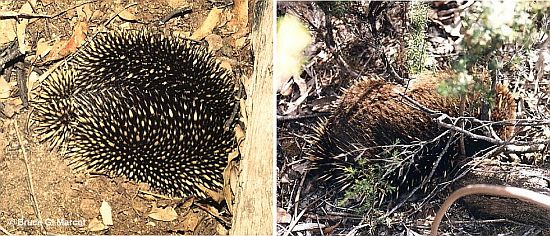 |
|
A Tale of Two Echidnas |
|
|
Click on the image for a larger version
 |
|
A Tale of Two Echidnas |
|
Short-beaked Echidna (Tachyglossus aculeatus) |
Credit & Copyright: Dr. Bruce G. Marcot
| Explanation:
Only three species of mammals on
Earth lay eggs
-- the Duck-billed Platypus
and two species of echidna. Shown above are two photos of the Short--beaked
Echidna of Australia (the much larger and threatened Long-beaked
Echidna resides only in New Guinea). But can these two photos
really be the same species?
Yes. The left photo was taken in New South Wales of southeast Australia, and the right photo in Tasmania (the island state of Australia to the south). Echidnas everywhere are covered in sharp spines, derived from modified hair (keratin), that molt annually and serve as predator defenses. However, echidnas in Tasmania are also covered in dense long fur and have shorter spines. This is clearly an adaptation to the colder climate there ... and perhaps the shorter spines are a physiological tradeoff of having dense fur, or perhaps there was less evolutionary need for such Draconian predator defense on isolated Tasmania. Some authors consider the Tasmanian form to be a separate subspecies, in fact. Monotremes date back to the Cretaceous Period of 100 million years ago in Australia. |
Next week's picture: Skin Patterns
Member Theme of Taos-Telecommunity